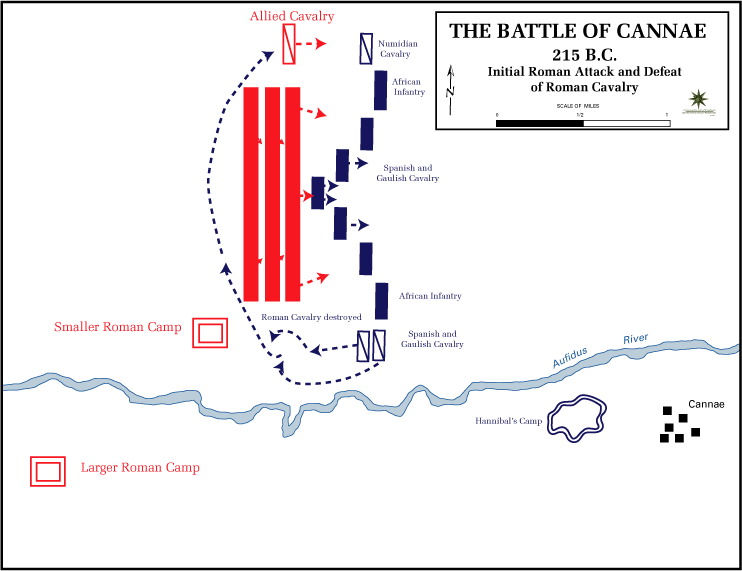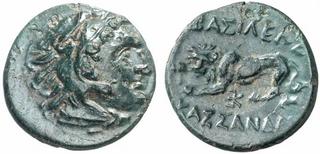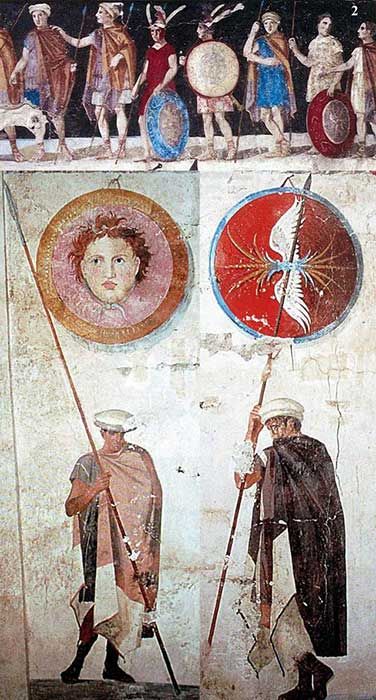|
Seleucid–Mauryan War
The Seleucid–Mauryan War was fought between 305 and 303 BC. It started when Seleucus I Nicator, of the Seleucid Empire, sought to retake the Indian satrapies of the Macedonian Empire which had been occupied by Emperor Chandragupta Maurya, of the Maurya Empire. The war ended in a settlement resulting in the annexation of the Indus Valley region and part of Afghanistan to the Mauryan Empire, with Chandragupta securing control over the areas that he had sought, and a marriage alliance between the two powers. After the war, the Mauryan Empire emerged as the dominant power of the Indian subcontinent, and the Seleucid Empire turned its attention toward defeating its rivals in the west. Background Chandragupta Maurya established himself as ruler of Magadha around 321 BC. He decided to conquer the Nanda Dynasty, rulers at the time of the Gangetic Plain. He fought the empire for eleven years with successful guerrilla campaigns, and captured the Nanda capital of Pataliputra. This ... [...More Info...] [...Related Items...] OR: [Wikipedia] [Google] [Baidu] |
Maurya Empire
The Maurya Empire, or the Mauryan Empire, was a geographically extensive Iron Age historical power in the Indian subcontinent based in Magadha, having been founded by Chandragupta Maurya in 322 BCE, and existing in loose-knit fashion until 185 BCE. Quote: "Magadha power came to extend over the main cities and communication routes of the Ganges basin. Then, under Chandragupta Maurya (c.321–297 bce), and subsequently Ashoka his grandson, Pataliputra became the centre of the loose-knit Mauryan 'Empire' which during Ashoka's reign (c.268–232 bce) briefly had a presence throughout the main urban centres and arteries of the subcontinent, except for the extreme south." The Maurya Empire was centralized by the conquest of the Indo-Gangetic Plain, and its capital city was located at Pataliputra (modern Patna). Outside this imperial center, the empire's geographical extent was dependent on the loyalty of military commanders who controlled the armed cities sprinkling it. During Ash ... [...More Info...] [...Related Items...] OR: [Wikipedia] [Google] [Baidu] |
Nanda Dynasty
The Nanda dynasty ruled in the northern part of the Indian subcontinent during the fourth century BCE, and possibly during the fifth century BCE. The Nandas overthrew the Shaishunaga dynasty in the Magadha region of eastern India, and expanded their empire to include a larger part of northern India. Ancient sources differ considerably regarding the names of the Nanda kings and the duration of their rule, but based on the Buddhist tradition recorded in the '' Mahavamsa'', they appear to have ruled during ''circa'' 345–322 BCE, although some theories date the start of their rule to fifth century BCE. The Nandas built on the successes of their Haryanka and Shaishunaga predecessors, and instituted a more centralised administration. Ancient sources credit them with amassing great wealth, which was probably a result of introduction of new currency and taxation system. Ancient texts also suggest that the Nandas were unpopular among their subjects because of their low status birth, e ... [...More Info...] [...Related Items...] OR: [Wikipedia] [Google] [Baidu] |
Punjab
Punjab (; Punjabi: پنجاب ; ਪੰਜਾਬ ; ; also romanised as ''Panjāb'' or ''Panj-Āb'') is a geopolitical, cultural, and historical region in South Asia, specifically in the northern part of the Indian subcontinent, comprising areas of eastern Pakistan and northwestern India. Punjab's capital and largest city and historical and cultural centre is Lahore. The other major cities include Faisalabad, Rawalpindi, Gujranwala, Multan, Ludhiana, Amritsar, Sialkot, Chandigarh, Jalandhar, and Bahawalpur. Punjab grew out of the settlements along the five rivers, which served as an important route to the Near East as early as the ancient Indus Valley civilization, dating back to 3000 BCE, and had numerous migrations by the Indo-Aryan peoples. Agriculture has been the major economic feature of the Punjab and has therefore formed the foundation of Punjabi culture, with one's social status being determined by land ownership. The Punjab emerged as an important agricultura ... [...More Info...] [...Related Items...] OR: [Wikipedia] [Google] [Baidu] |
Hindu Kush
The Hindu Kush is an mountain range in Central and South Asia to the west of the Himalayas. It stretches from central and western Afghanistan, Quote: "The Hindu Kush mountains run along the Afghan border with the North-West Frontier Province of Pakistan". into northwestern Pakistan and far southeastern Tajikistan. The range forms the western section of the ''Hindu Kush Himalayan Region'' (''HKH''); to the north, near its northeastern end, the Hindu Kush buttresses the Pamir Mountains near the point where the borders of China, Pakistan and Afghanistan meet, after which it runs southwest through Pakistan and into Afghanistan near their border. The eastern end of the Hindu Kush in the north merges with the Karakoram Range.Karakoram Range: MOUNTAINS, ASIA Encyclopædia Britannica Towards its s ... [...More Info...] [...Related Items...] OR: [Wikipedia] [Google] [Baidu] |
Pitched Battle
A pitched battle or set-piece battle is a battle in which opposing forces each anticipate the setting of the battle, and each chooses to commit to it. Either side may have the option to disengage before the battle starts or shortly thereafter. A pitched battle is not a chance encounter such as a meeting engagement, or where one side is forced to fight at a time not of its choosing such as happens in a siege or an ambush. Pitched battles are usually carefully planned, to maximize one's strengths against an opponent's weaknesses, and use a full range of deceptions, feints, and other manoeuvres. They are also planned to take advantage of terrain favourable to one's force. Forces strong in cavalry for example will not select swamp, forest, or mountain terrain for the planned struggle. For example, Carthaginian general Hannibal selected relatively flat ground near the village of Cannae for his great confrontation with the Romans, not the rocky terrain of the high Apennines. Likewise, ... [...More Info...] [...Related Items...] OR: [Wikipedia] [Google] [Baidu] |
Peithon (son Of Agenor)
Peithon ( grc, Πείθων) (died 312 BC), son of Agenor (Αγήνωρ) was an officer in the expedition of Alexander the Great to India, who became satrap of the Indus from 325 to 316 BC, and then satrap of Babylon, from 316 to 312 BC, until he died at the Battle of Gaza in 312 BC. Officer Peithon was very successful in his Indian campaigns, first mentioned as the commander of a phalanx battalion in January 325 in the Mallian Campaign (Indian Mâlava) in the southern Punjab. Satrap of the Indus (325–316 BC) After these deeds, Alexander named him viceroy of the Indus area, around 325 BC, to the east of the territory held in the Paropamisadae by the satrap Oxyartes and to the south of the territories where Philip, son of Machatas was satrap: :"He (Alexander) appointed Peithon viceroy of the land extending from the confluence of the Indus and Acesines as far as the sea, together with all the coast-land of India" Arrian Anabasis Book 6b Later, Peithon managed putting down ... [...More Info...] [...Related Items...] OR: [Wikipedia] [Google] [Baidu] |
Eudemus (general)
Eudemus ( grc, Εὔδημος; died 316 BC) was one of Alexander the Great's generals. In 326 BC he was appointed by Alexander as one of the commanders of the troops in India along with Peithon, Porus and Taxiles. After Alexander's death, Eudemus assassinated Porus (Some Historians say that it is false) and effectively controlled Alexander's northern Indian territories until he became involved in the Wars of the Diadochi during which he was captured and killed by Antigonus. Biography In 326 BC Eudemus was appointed by Alexander the Great to the command of the troops left in India, after the murder of the Alexander-appointed satrap Philip (son of Machatas) by his own mercenary troops in 326 BC. Alexander dispatched letters to India to Eudemus and also to Taxilas telling them to take charge of the district formerly under Philip, until Alexander could send a satrap to govern the district. According to Diodorus Siculus after Alexander's unexpected death in 323 BC, Eudemus assassi ... [...More Info...] [...Related Items...] OR: [Wikipedia] [Google] [Baidu] |
Philip (satrap)
Philip ( grc, Φίλιππος; died 318 BC) was satrap of Sogdiana. He was first appointed to this position by Alexander the Great in 327 BC. He retained his post, as did most of the satraps of the more remote provinces, in the arrangements which followed the death of the king in 323 BC; but in the subsequent partition at Triparadisus in 321 BC, he was assigned the government of Parthia instead. Here he remained until 318 BC, when Peithon, who was then seeking to establish his power over all the provinces of the East, made himself master of Parthia, and put Philip to death. References * Smith, William (editor); ''Dictionary of Greek and Roman Biography and Mythology''"Philippus (9)" Boston Boston (), officially the City of Boston, is the state capital and most populous city of the Commonwealth of Massachusetts, as well as the cultural and financial center of the New England region of the United States. It is the 24th- mo ..., (1867) Notes ---- 318 BC deaths ... [...More Info...] [...Related Items...] OR: [Wikipedia] [Google] [Baidu] |
Nicanor (Antipatrid General)
Nicanor (; el, Nικάνωρ ''Nīkā́nōr''; executed 317 BC) was a Macedonian officer who served the Diadochus Cassander and the son in law of Aristotle. He campaigned on Cassander's behalf in Attica and Hellespont during the early Wars of the Diadochi, but was executed by Cassander after the latter suspected him of plotting a coup. Career According to A.B. Bosworth (Professor of Classics and Ancient History, The University of Western Australia), Nicanor was a son of Balacrus and Phila, making him both the son in law and adopted son of Aristotle. During the Olympic Games of 324 BC, Nicanor acted as the representative of Alexander the Great reading a proclamation that ordered Greek city states to welcome back people they had sent into exile. During the Wars of the Diadochi, Nicanor served as an officer of Cassander who dispatched him immediately on the death of Antipater in 319 BC to replace Menyllus as commander of the Macedonian garrison at Munychia in Attica. He arrived ... [...More Info...] [...Related Items...] OR: [Wikipedia] [Google] [Baidu] |
Satrap
A satrap () was a governor of the provinces of the ancient Median and Achaemenid Empires and in several of their successors, such as in the Sasanian Empire and the Hellenistic empires. The satrap served as viceroy to the king, though with considerable autonomy. The word came to suggest tyranny or ostentatious splendour, and in modern usage refers to any subordinate or local ruler, usually with unfavourable connotations of corruption. A satrapy is the territory governed by a satrap. Etymology The word is derived via Latin from Greek ''satrápes'' (), itself borrowed from an Old Iranian ''*khshathra-pa''. In Old Persian, which was the native language of the Achaemenids, it is recorded as ''khshathapavan'' (, literally "protector of the province"). The Median form is reconstructed as ''*khshathrapavan-''. It is cognate with Sanskrit ''kshetrapal'' (). The Biblical Hebrew form is ''aḥashdarpan'' , as found in . In the Parthian (language of the Arsacid Empire) and Middle Persia ... [...More Info...] [...Related Items...] OR: [Wikipedia] [Google] [Baidu] |
Appian
Appian of Alexandria (; grc-gre, Ἀππιανὸς Ἀλεξανδρεύς ''Appianòs Alexandreús''; la, Appianus Alexandrinus; ) was a Greek historian with Roman citizenship who flourished during the reigns of Emperors of Rome Trajan, Hadrian, and Antoninus Pius. He was born c. 95 in Alexandria. After holding the senior offices in the province of Aegyptus (Egypt), he went to Rome c. 120, where he practised as an advocate, pleading cases before the emperors (probably as ''advocatus fisci'', an important official of the imperial treasury). It was in 147 at the earliest that he was appointed to the office of procurator, probably in Egypt, on the recommendation of his friend Marcus Cornelius Fronto, an influential rhetorician and advocate. Because the position of procurator was open only to members of the equestrian order (the "knightly" class), his possession of this office tells us about Appian's family background. His principal surviving work (Ρωμαϊκά ''Romaiká'' ... [...More Info...] [...Related Items...] OR: [Wikipedia] [Google] [Baidu] |
Wars Of The Diadochi
The Wars of the Diadochi ( grc, Πόλεμοι τῶν Διαδόχων, '), or Wars of Alexander's Successors, were a series of conflicts that were fought between the generals of Alexander the Great, known as the Diadochi, over who would rule his Macedonia (ancient kingdom)#Empire, empire following his death. The fighting occurred between 322 and 281 BC. Background Alexander the Great died on June 10, 323 BC, leaving behind an empire that stretched from Macedon and the rest of Hellenistic Greece, Greece in Europe to the Indus valley in South Asia. The empire had no clear successor, with the Argead dynasty, Argead family, at this point, consisting of Alexander's mentally disabled half-brother, Philip III of Macedon, Arrhidaeus; his unborn son Alexander IV of Macedon, Alexander IV; his reputed illegitimate son Heracles, son of Alexander, Heracles; his mother Olympias; his sister Cleopatra of Macedon, Cleopatra; and his half-sisters Thessalonike of Macedon, Thessalonike and Cynan ... [...More Info...] [...Related Items...] OR: [Wikipedia] [Google] [Baidu] |


.jpg)





